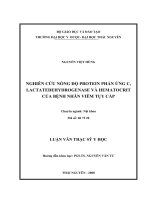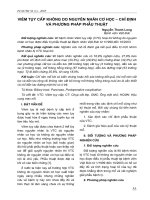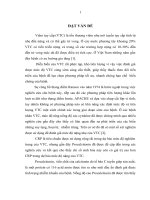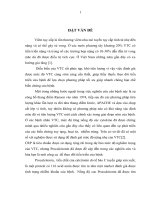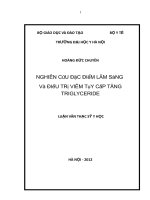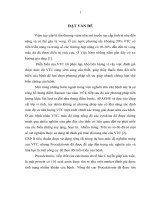VIÊM tụy cấp
Bạn đang xem bản rút gọn của tài liệu. Xem và tải ngay bản đầy đủ của tài liệu tại đây (6.39 MB, 36 trang )
VIÊM TỤY CẤP
VIÊM TỤY CẤP
ĐỊNH NGHĨA:
Là một cấp cứu nội khoa thường gặp
Là quá trình viêm cấp tính
Topazian M., Pandol S.J. Textbook of Gastroenterology 5th ed. 2009. Chapter 68.
VIÊM TỤY CẤP
Không
rõ NN
Tự miễn
Di truyền
Do điều trị
Nhiễm trùng
Sỏi mật
Chuyển hóa
NN khác
Ung thư
Tắc nghẽn
Rượu
Độc chất
Chấn thương
Mạch máu
Khác
Topazian M., Pandol S.J. Textbook of Gastroenterology 5th ed. 2009. Chapter 68.
TRIỆU CHỨNG LS
Bệnh sử:
Đau bụng
Buồn nôn, nôn
Khám:
Sốt nhẹ - TB
Nhịp tim nhanh
Hạ HA
Bụng đề kháng thượng vị
Giảm/mất âm ruột
Triệu chứng TDMP (T)
Vàng da nhẹ
Bầm da hông lưng hoặc quanh rốn
CẬN LÂM SÀNG
Amylase máu
Lipase máu
Các dấu ấn viêm: Tăng bạch cầu, Neutrophil-
specific elastase, Interleukin-6, CRP
Đánh giá cô đặc máu: Hct
CẬN LÂM SÀNG
X quang: bụng và ngực thẳng
Siêu âm bụng
CT bụng
MRI
ERCP
EUS
Dấu Cullen và Grey Turner
Markus B. et al. The American Journal of Medicine , Volume 122 (4) Elsevier – Apr 1, 2009
Topazian M., Pandol S.J. (2009). Textbook of Gastroenterology
5th edition. Blackwell Publishing
Norton J.G. and Phillip P.T. (2012). Harrison’s Principles of
Internal Medicine, 18th edition. The McGraw-Hill Companies
VIÊM TỤY CẤP
CHẨN ĐOÁN: 2 trong 3 tiêu chuẩn sau
1. Các triệu chứng, như đau thượng vị, gợi ý VTC
2. Amylase hoặc lipase máu > 3 lần giới hạn trên
bình thường
3. Hình ảnh học hướng chẩn đoán VTC, thường
dùng siêu âm (độ nhạy 25-50%), CT-Scan hoặc
MRI
1. Banks P.A. et al. Practice Guidelines in Acute Pancreatitis. Am J Gastroenterol 2006;101:2379–2400
2. UK Working Party on Acute Pancreatitis. UK Guidelines For The Management Of Acute Pancreatitis.
Gut 2005;54 (Suppl III):iii1–iii9. doi: 10.1136/gut.2004.057026
Thượng vị
Khám: đề
kháng ½
bụng trên
Kèm buồn
nôn, nôn
Lan lưng
Đau
bụng
Kéo dài ≥
24h, không
giảm
Khởi phát
nhanh
Tăng dầntối
đa trong 30’
Amylase
Lipase
ULN
100
190
Bắt đầu tăng
Ngày 1
Ngày 1
Về bình thường sau 3 – 5 ngày
Tăng kéo dài hơn
• VTC do rượu
• Tăng TG
Men tụy có thể
• Ung thư tụy
không tăng trong
• VTC trên VT mạn
• Loét thâm nhiễm
CHỈ ĐỊNH CHỤP CT-SCAN
1. Chẩn đoán xác định khi lâm sàng và XN không
đủ chẩn đoán
2. Xác định mức độ nặng, các biến chứng tại tụy
và quanh tụy (khi còn đau bụng hoặc lâm sàng
xấu đi sau 48 – 72 giờ)
3. Hướng dẫn can thiệp qua da (như catheter dẫn
lưu ổ dịch)
1. Bharwani N. et al. Clinical Radiology 66 (2011) 164 -175.
2. Wu B.U. et al. Current Diagnosis & Treatment: Gastroenterology, Hepatology & Endoscopy 2 nd ed. 2012. Chapter 25
MỨC ĐỘ VIÊM TỤY CẤP
Nhẹ
Trung bình
Không suy tạng Suy tạng thoáng
qua (hồi phục trong
48h)
Không biến
chứng tại chỗ
Biến chứng tại chỗ
hoặc toàn thân mà
không suy tạng
Gut 2012;0:1–10. doi:10.1136/gutjnl-2012-302779
Nặng
Suy tạng kéo dài
(>48h):
•Suy một tạng
•Suy đa tạng
BIẾN CHỨNG TẠI CHỖ
Tụ dịch quanh tụy cấp
Nang giả tụy
Hoại tử tụy/quanh tụy cấp +/- nhiễm
trùng
Hoại tử tụy/quanh tụy có vách +/- nhiễm
trùng
BIẾN CHỨNG SUY TẠNG
VIÊM TỤY CẤP
TIÊN LƯỢNG:
Hct > 44% lúc NV và không thể giảm sau 24h
CRP > 150mg/l sau khởi phát 48h
SIRS lúc NV + kéo dài sau 48h: ≥ 2/4 tiêu
chuẩn
1. to > 38oC hoặc < 36oC
2. Nhịp tim > 90 l/p
3. Nhịp thở > 20 l/p hoặc PaCO2 < 32 mmHg
4. BC > 12000 hoặc < 4000/mm3
VIÊM TỤY CẤP
TIÊN LƯỢNG:
Thang điểm BISAP (Bedside Index of Severe
Acute Pancreatitis): Viêm tụy cấp nặng khi có ≥ 3
tiêu chuẩn sau:
1. (B): BUN > 25g/dL
2. (I): Rối loạn tri giác, điểm Glasgow < 15
3. (S): Hội chứng đáp ứng viêm toàn thân
4. (A): Tuổi > 60
5. (P): Tràn dịch màng phổi
VIÊM TỤY CẤP
Trong vòng 48 giờ
TIÊU
CHUẨN
GLASGOW
≥ 3đ
TIÊU
CHUẨN
RANSON
≥3đ
Do sỏi
Không do
sỏi
Lúc nhập viện
Tuổi
> 55
> 70
Bạch cầu
> 16.000/mm3 > 18.000/mm3
máu
Glucose máu > 200 mg/dL > 220 mg/dL
LDH máu
> 350 UI/L
> 400 UI/L
AST máu
> 250 UI/L
> 250 UI/L
Trong 48 giờ đầu nhập viện
Giảm Hct
> 10 %
10 %
Tăng BUN
> 5 mg/dL
> 2 mg/dL
Can xi máu
< 8 mg/dL
< 8 mg/dL
PaO2
< 60 mmHg
Mất kiềm
> 4 mEq/L
> 5 mEq/L
Mất dòch
>6L
>4L
APACHE-II
TIÊN LƯỢNG
CRP
SIRS
GLASGOW
RANSON
APACHE-II
48H
Hct
GLASGOW
APACHE-II
24H
LÚC NV
Hct
SIRS
BISAP
GLASGOW
APACHE-II
BÌNH THƯỜNG
Fig. 1. Normal contrast-enhanced computed
tomogram of the pancreas. Note that the pancreas
(P) has a uniform enhancement intermediate
between that of the liver (L) and spleen (S). [1]
VIÊM CẤP
Figure 45.12 Computed tomography scan with
intravenous contrast demonstrating moderate acute
pancreatitis. The pancreas (arrow) is edematous,
but enhances throughout, demonstrating absence of
necrosis. There is peripancreatic fl uid and stranding
(arrowhead). Gallstones are present in the gallbladder
(double arrowhead). [2]
1. Vege S.S., Baron T.H. Mayo Clinic Gastroenterology and Hepatology Board Review 3 rd ed. 2008.
2. Nagar A.B., Pandol S.J. Atlas of Gastroenterology 4th ed. Blackwell Publishing Ltd. 2009.
Figure 45.18 Contrast computed tomography scan of pancreas. (a) Pseudocyst is seen near the tail of
pancreas (arrow), the pancreas is seen (arrowhead). (b) Ascites is observed (double arrowheads) with
resolution of pseudocyst following the rare complication of pseudocyst rupture. Pancreas is also seen
(arrowhead).
NANG
GIẢ
TỤY
Nagar A.B., Pandol S.J. Atlas of Gastroenterology 4th ed. Blackwell Publishing Ltd. 2009.
Pancreatic abscess. Dynamic CECT through
the uncinate portion of the pancreas reveals a
5 cm, irregular, thick-walled, low attenuation
fluid collection (arrows) lying medial to the
second portion of the duodenum. The thick
wall suggests that this collection may not
represent a simple pseudocyst, however,
needle aspiration of pus is necessary to prove
pancreatic abscess. [1]
Pancreatic abscess with a typical enhancing
rim and gas locules. [2]
ÁP XE
1. Baron T.H. The American Journal of Medicine. Volume 102, Issue 6, June 1997, Pages 555–563
2. Koo B.C., Chinogureyi A. and Shaw A.S. The British Journal of Radiology, 83 (2010), 104–112
